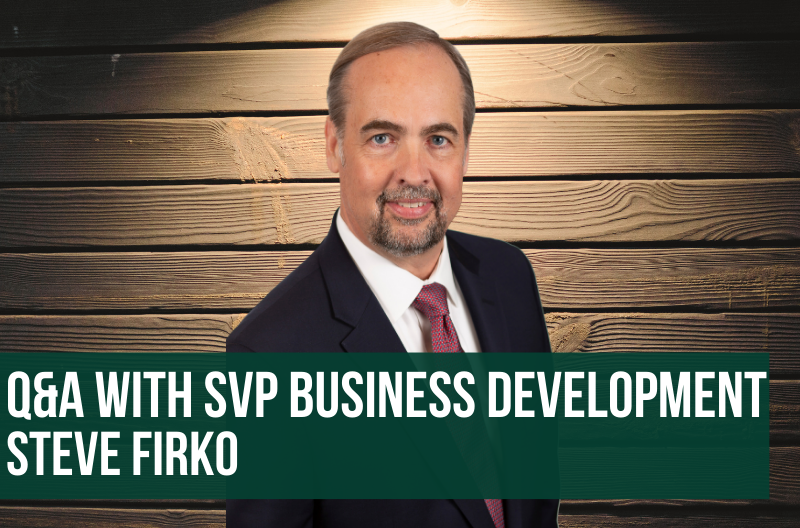We’re very excited to unveil our latest video from our new blog series titled “Insights from the Top: 3 Questions with PLM Leaders.” Every month, we’ll feature a different member of our leadership team, offering their perspectives on industry trends and the crucial role PLM plays in addressing the needs of the wood niche.
In this month’s edition, we are joined by Steve Firko, SVP – Business Development, Loss Control & Customer Service.
Q. Insights from the Top: Can we talk about the value of the mutual model to customers?
A. Steve Firko: One advantage of mutual insurance companies over those owned by stockholders lies in their exclusive focus on policyholders. Unlike stock-held companies preoccupied with pleasing shareholders and meeting quarterly financial targets, mutual insurers prioritize the needs of policyholders above all else. This singular dedication ensures that decisions are made with the best interests of policyholders in mind, rather than being swayed by profit-driven motives. This commitment to policyholder satisfaction is a crucial factor for individuals seeking insurance coverage, as it guarantees a level of service and support that extends beyond mere financial considerations.
For instance, consider the case of Pennsylvania Lumbermens Mutual (PLM) Business, which serves as a testament to the effectiveness of mutual insurance structures. Founded over a century ago by lumber dealers dissatisfied with the options offered by stock-held insurers, this mutual company was established to address the specific needs of its members. By pooling resources and expertise within their community, lumber dealers were able to create a tailored insurance solution that provided comprehensive coverage at fair prices. This mutual arrangement not only ensured affordable protection for lumber dealers but also fostered a sense of ownership and belonging among members, who actively participated in shaping the company’s direction. Over the years, this mutually beneficial relationship has stood the test of time, underscoring the enduring value of mutual insurance models in serving specialized industries.
Q. Insights from the Top: What do you see in the future of your department to better serve our customers?
A. Steve Firko: Mutual companies offer a remarkable advantage, especially when considering the longevity of businesses in the United States. Surprisingly, only 1% of companies nationwide have survived more than a century, a fact that I discovered during my research. However, within the realm of mutual companies, nearly 60% have surpassed the century mark, with a median age of 120 years. Take PLM, for instance, thriving for 129 years. This endurance can be attributed to mutual companies’ profound understanding of their customers, placing a strong emphasis on service rather than mere insurance. Their agility in adapting to evolving industries and unique customer needs has been pivotal in maintaining stability over time, a characteristic less commonly observed in publicly traded insurance entities.
Moreover, mutual companies’ close alignment with the industries they serve fosters enduring relationships with multi-generational customers. Many of these customers, spanning generations, have witnessed the evolution of their businesses alongside mutual insurers like PLM. As technology advances and complexities arise, mutual insurers have adeptly navigated these changes, offering tailored coverages and steadfast support, distinguishing themselves from stock-held counterparts. This alignment ensures that mutual insurers remain closely intertwined with their customers’ growth and development, a partnership that transcends mere financial transactions, fostering resilience and longevity in an ever-changing landscape.
Q. Insights from the Top: Can you share some interesting takeaways from trade shows or site visits?
A. Steve Firko: People often inquire about the significance of attending trade shows and conducting site visits with customers. At PLM, our deep commitment to the industries we serve drives us to participate in over 133 trade shows annually. These events provide invaluable opportunities to engage directly with our customers within their respective trade associations and buying groups. By immersing ourselves in these environments, we gain firsthand insights into emerging industry issues that cannot be fully grasped through online research or trade publications alone. The face-to-face interactions foster meaningful dialogues, allowing us to address questions about insurance while also learning about industry trends and challenges from our customers’ perspectives. This exchange of knowledge strengthens our bonds with customers and enhances our ability to tailor solutions to their evolving needs.
Furthermore, our unique business model, characterized by an open brokerage environment, facilitates direct engagement between PLM, brokers, and clients. Unlike traditional setups where insurers appoint agencies, we empower clients to choose their representatives, fostering a sense of trust and collaboration. This approach streamlines access to our insurance products and enables us to work closely with brokers and clients to develop customized risk management programs. Our dedicated business development representatives leverage their dual expertise in insurance and industry-specific hazards to conduct thorough onsite assessments, providing comprehensive recommendations to mitigate potential risks. This collaborative effort ensures that clients receive holistic insurance coverage tailored to their specific operations, ultimately minimizing the likelihood of losses, and promoting proactive risk management practices.
Moreover, conducting onsite visits allows us to identify potential risks and offer targeted recommendations to mitigate them effectively. By engaging in three-way communication between PLM, brokers, and clients, we foster a synergistic approach to risk management. This collaborative effort, often referred to as the PLM triangle, enables us to leverage collective expertise and insights to design optimal insurance programs. Through this iterative process of dialogue, assessment, and action, we not only enhance our clients’ understanding of risk but also empower them to make informed decisions to safeguard their businesses. Overall, our commitment to open communication, personalized service, and proactive risk mitigation underscores our dedication to supporting our clients’ long-term success in a rapidly evolving landscape.

